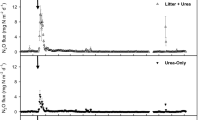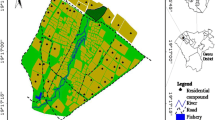Abstract
Emissions of N2O were measured following combined applications of inorganic N fertiliser and crop residues to a silt loam soil in S.E. England, UK. Effects of cultivation technique and residue application on N2O emissions were examined over 2 years. N2O emissions were increased in the presence of residues and were further increased where NH4NO3 fertiliser (200 kg N ha−1) was applied. Large fluxes of N2O were measured from the zero till treatments after residue and fertiliser application, with 2.5 kg N2O-N ha−1 measured over the first 23 days after application of fertiliser in combination with rye (Secale cereale) residues under zero tillage. CO2 emissions were larger in the zero till than in the conventional till treatments. A significant tillage/residue interaction was found. Highest emissions were measured from the conventionally tilled bean (Vicia faba) (1.0 kg N2O-N ha−1 emitted over 65 days) and zero tilled rye (3.5 kg N2O-N ha−1 over 65 days) treatments. This was attributed to rapid release of N following incorporation of bean residues in the conventionally tilled treatments, and availability of readily degradable C from the rye in the presence of anaerobic conditions under the mulch in the zero tilled treatments. Measurement of 15N-N2O emission following application of 15N-labelled fertiliser to microplots indicated that surface mulching of residues in zero till treatments resulted in a greater proportion of fertiliser N being lost as N2O than with incorporation of residues. Combined applications of 15N fertiliser and bean residues resulted in higher or lower emissions, depending on cultivation technique, when compared with the sum of N2O from single applications. Such interactions have important implications for mitigation of N2O from agricultural soils.
Similar content being viewed by others
References
Aulakh M S, Doran J W, Walters D T, Mosier A R and Francis D D 1991 Crop residue type and placement effects on denitrification and mineralisation. Soil Sci. Soc. Am. J. 55, 1020–1025.
Aulakh M S, Rennie D A and Paul E A 1984 The influence of plant residues on denitrification rates in conventional and zero-tilled soils. Soil Sci. Soc. Am. J. 48, 790–794.
Azam F, Malik K A and Sajjad M I 1985 Transformations in soil and availability to plants of 15N applied as inorganic fertilizer and legume residues. Plant Soil 86, 3–13.
Baggs E M, Rees R M, Smith K A and Vinten A J A 2000 Nitrous oxide emission from soils after incorporating crop residues. Soil Use Manage. 16, 82–87.
Bouwman A F 1996 Direct emission of nitrous oxide from agricultural soils. Nutr. Cycl. Agroecosyst. 46, 53–70.
Broder M W, Doran J W, Peterson J A and Fenster C R 1984 Fallow tillage influence on spring populations of soil nitrifiers, denitrifiers and available nitrogen. Soil Sci. Soc. Am. J. 48, 1060–1067.
Clayton H, McTaggart I P, Parker J, Swan L and Smith K A 1997 Nitrous oxide on fertilised grassland: a two year study of the effects of N-fertiliser form and environmental conditions. Biol. Fertil. Soils 25, 252–260.
Crutzen P J 1976 The influence of nitrogen oxides on the atmospheric ozone content. Quarterly J. R. Meteorol. Soc. 96, 320–325.
Doran J W 1980a Microbial changes associated with residue management and reduced tillage. Soil Sci. Soc. Am. J. 44, 518–524.
Doran J W 1980b Soil microbial and biochemical changes associated with reduced tillage. Soil Sci. Soc. Am. J. 44, 765–771.
Duxbury J M and McConnaughey P K 1986 Effect of fertiliser source on denitrification and nitrous oxide emissions in a maize field. Soil Sci. Soc. Am. J. 50, 644–648.
Handayanto E, Cadisch G and Giller K E 1997 Regulating N mineralization from plant residues by manipulation of quality. In Driven by Nature: Plant Litter Quality and Decomposition. Eds. Cadisch and Giller. pp. 175–186.
Houghton J T, Jenkins G J and Ephraums J J Eds 1990 Climate Change: The IPCC Assessment. Cambridge University Press, Cambridge.
Kaiser E A, Hohrs K, Kücke M, Schnug E, Heinemeyer O and Munch J C 1998 Nitrous oxide release from arable soil: importance of N-fertilization, crops and temporal variation. Soil Biol. Biochem. 30, 1553–1563.
Kroeze C, Mosier A and Bouwman A F 1999 Closing the global N2O budget: a retrospective analysis 1500–1994. Global Biogeochem. Cycles 13, 1–8.
Linn D M and Doran J W 1984 Aerobic and anaerobic microbial populations in no-till and plowed soils. Soil Sci. Soc. Am. J. 48, 794–799.
Mosier A R 1994 Nitrous oxide emissions from agricultural soils. Fertil. Res. 37, 191–200.
Mosier A R, Duxbury JM, Freney J R, Heinemeyer O and Minami K 1998 Assessing and mitigating N2O emissions from agricultural soils. Climatic Change 40, 7–38.
Parkin T B and Robinson J A 1993 Statistical evaluation of median estimators for lognormally distributed variables. Soil Sci. Soc. Am. J. 57, 317–323.
Reinertsen S A, Elliott L F, Cochran V L and Campbell G S 1984 Role of available carbon and nitrogen in determining the rate of wheat straw decomposition. Soil Biol. Biochem. 16, 459–464.
Smith K A, Clayton H, McTaggart I P, Thomson P E, Arah J R M and Scott A 1995 The measurement of nitrous oxide emissions from soil by using chambers. Phil. Trans. R. Soc. London, A 351, 327–338.
Smith S J and Sharpley A N 1990 Soil nitrogen mineralisation in the presence of surface and incorporated crop residues. Agron. J. 82, 112–116.
Stott D E, Elliott L F, Papendick R I and Campbell G S 1986 Low temperature or low water effects on microbial decomposition of wheat residue. Soil Biol. Biochem. 18, 577–582.
Varco J J, Frye W W, Smith M S and Mackown C T 1989 Tillage effects on nitrogen recovery by corn from a nitrogen-15 labelled legume cover crop. Soil Sci. Soc. Am. J. 53, 822–827.
Author information
Authors and Affiliations
Corresponding author
Rights and permissions
About this article
Cite this article
Baggs, E., Stevenson, M., Pihlatie, M. et al. Nitrous oxide emissions following application of residues and fertiliser under zero and conventional tillage. Plant and Soil 254, 361–370 (2003). https://doi.org/10.1023/A:1025593121839
Issue Date:
DOI: https://doi.org/10.1023/A:1025593121839




